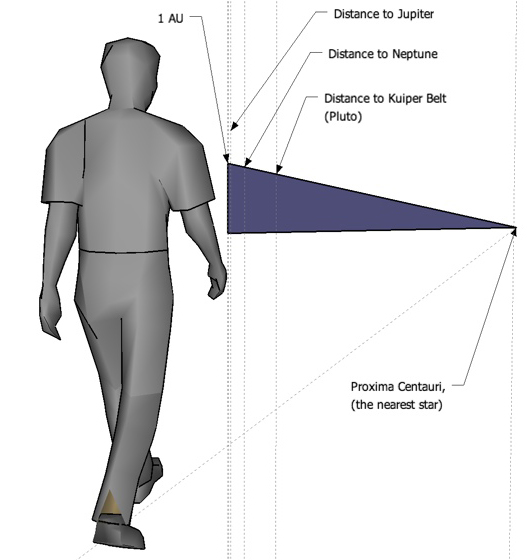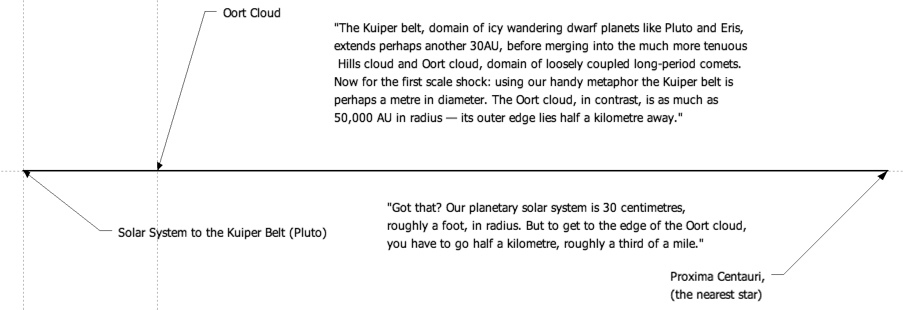June 17, 2007
Voyager

As some of you may know, I am a fan of time and scale lines. I thought of Hiroshi when I read this article about the realities of space travel since he is a huge fan of the Powers of Ten by the famous husband and wife designer team, Charles and Ray Eames. Hiroshi spoke of his regard of his paintings in these terms, a floating aloft and away into space as small conflates with the large, a vital key in understanding his paintings.
Today, I came across a spoilsport who argues for some perspective when we think about space exploration:
...And I don't want to spend much time talking about the unspoken ideological underpinnings of the urge to space colonization, other than to point out that they're there, that the case for space colonization isn't usually presented as an economic enterprise so much as a quasi-religious one. "We can't afford to keep all our eggs in one basket" isn't so much a justification as an appeal to sentimentality, for in the hypothetical case of a planet-trashing catastrophe, we (who currently inhabit the surface of the Earth) are dead anyway. The future extinction of the human species cannot affect you if you are already dead: strictly speaking, it should be of no personal concern.Historically, crossing oceans and setting up farmsteads on new lands conveniently stripped of indigenous inhabitants by disease has been a cost-effective proposition. But the scale factor involved in space travel is strongly counter-intuitive.
Here's a handy metaphor: let's approximate one astronomical unit ? the distance between the Earth and the sun, roughly 150 million kilometres, or 600 times the distance from the Earth to the Moon ? to one centimetre. Got that? 1AU = 1cm. (You may want to get hold of a ruler to follow through with this one.)

Towards the end of this missive, this writer notes an exception to his rule of the limits of scale, the space elevator!:
Let me repeat myself: we are not going there with rockets. At least, not the conventional kind ? and while there may be a role for nuclear propulsion in deep space, in general there's a trade-off between instantaneous thrust and efficiency; the more efficient your motor, the lower the actual thrust it provides. Some technologies such as the variable specific impulse magnetoplasma rocket show a good degree of flexibility, but in general they're not suitable for getting us from Earth's surface into orbit ? they're only useful for trucking things around from low earth orbit on out.Of course, I think vigorous human activity within one astronomical unit is just fine for our near future. Vigorous is a key word, it's time for us to ramp it up. Posted by Dennis at June 17, 2007 11:38 AMAgain, as with interstellar colonization, there are other options. Space elevators, if we build them, will invalidate a lot of what I just said. Some analyses of the energy costs of space elevators suggest that a marginal cost of $350/kilogram to geosynchronous orbit should be achievable without waving any magic wands (other than the enormous practical materials and structural engineering problems of building the thing in the first place). So we probably can look forward to zero-gee vacations in orbit, at a price. And space elevators are attractive because they're a scalable technology; you can use one to haul into space the material to build more. So, long term, space elevators may give us not-unreasonably priced access to space, including jaunts to the lunar surface for a price equivalent to less than $100,000 in today's money. At which point, settlement would begin to look economically feasible, except ...
Leave a comment